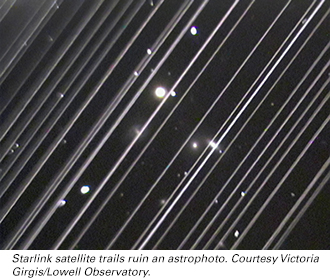AAS Issues Position Statement on Satellite Constellations
** Contact details appear below. **
 On May 23rd entrepreneur Elon Musk's company SpaceX launched 60 Starlink communication satellites aboard a single rocket. Within days skywatchers worldwide spotted them flying in formation as they orbited Earth and reflected sunlight from their shiny metal surfaces. Some people, unaware that artificial satellites can be seen moving against the starry background every clear night, reported UFO sightings. Astronomers, on the other hand, knew exactly what they were seeing — and immediately began to worry.
On May 23rd entrepreneur Elon Musk's company SpaceX launched 60 Starlink communication satellites aboard a single rocket. Within days skywatchers worldwide spotted them flying in formation as they orbited Earth and reflected sunlight from their shiny metal surfaces. Some people, unaware that artificial satellites can be seen moving against the starry background every clear night, reported UFO sightings. Astronomers, on the other hand, knew exactly what they were seeing — and immediately began to worry.
SpaceX had suggested that the satellites would be visible just barely, if at all. But for a few days after launch the Starlink constellation shone as brightly as many astronomical constellations, and SpaceX intends to launch thousands more such spacecraft as part of an effort to provide internet service to everyone in the world. "I think it's commendable and very impressive engineering to spread the information and opportunities made possible by internet access," says Megan Donahue (Michigan State University), President of the American Astronomical Society (AAS), "but I, like many astronomers, am very worried about the future of these new bright satellites." The Starlink satellites and similar swarms being developed by other companies could eventually outnumber the stars visible in our night sky.
On June 8th, at the 234th AAS meeting in St. Louis, Missouri, the AAS Board of Trustees adopted the following position statement on satellite constellations:
The American Astronomical Society notes with concern the impending deployment of very large constellations of satellites into Earth orbit. The number of such satellites is projected to grow into the tens of thousands over the next several years, creating the potential for substantial adverse impacts to ground- and space-based astronomy. These impacts could include significant disruption of optical and near-infrared observations by direct detection of satellites in reflected and emitted light; contamination of radio astronomical observations by electromagnetic radiation in satellite communication bands; and collision with space-based observatories.
The AAS recognizes that outer space is an increasingly available resource with many possible uses. However, the potential for multiple large satellite constellations to adversely affect both each other and the study of the cosmos is becoming increasingly apparent, both in low Earth orbit and beyond.
The AAS is actively working to assess the impacts on astronomy of large satellite constellations before their numbers rise further. Only with thorough and quantitative understanding can we properly assess the risks and identify appropriate mitigating actions. The AAS desires that this be a collaborative effort among its members, other scientific societies, and other space stakeholders including private companies. The AAS will support and facilitate the work by relevant parties to understand fully and minimize the impact of large satellite constellations on ground- and space-based astronomy.
"The natural night sky is a resource not just for astronomers but for all who look upward to understand and enjoy the splendor of the universe, and its degradation has many negative impacts beyond the astronomical," says Jeffrey C. Hall (Lowell Observatory), Chair of the AAS Committee on Light Pollution, Radio Interference, and Space Debris. "I appreciate the initial conversation we have already had with SpaceX, and I look forward to working with my AAS colleagues and with all stakeholders to understand and mitigate the effects of the rapidly increasing numbers of satellites in near-Earth orbit."
AAS President Donahue adds, "I'm looking forward to productive conversations between astronomers and SpaceX. I fully expect that we will come up with creative solutions that can serve as models for other companies to follow."
Contacts:
Rick Fienberg
AAS Press Officer
+1 202-328-2010 x116
Kevin B. Marvel
AAS Executive Officer
+1 202-328-2010 x114
A press kit (PDF) for the Starlink mission is available from SpaceX.
A high-resolution version of the image that appears above is available, with a detailed caption, from the International Astronomical Union.
The American Astronomical Society (AAS), established in 1899, is the major organization of professional astronomers in North America. Its membership of approximately 7,500 also includes physicists, mathematicians, geologists, engineers, and others whose research interests lie within the broad spectrum of subjects now comprising the astronomical sciences. The mission of the AAS is to enhance and share humanity's scientific understanding of the universe, which it achieves through publishing, meeting organization, education and outreach, and training and professional development.

